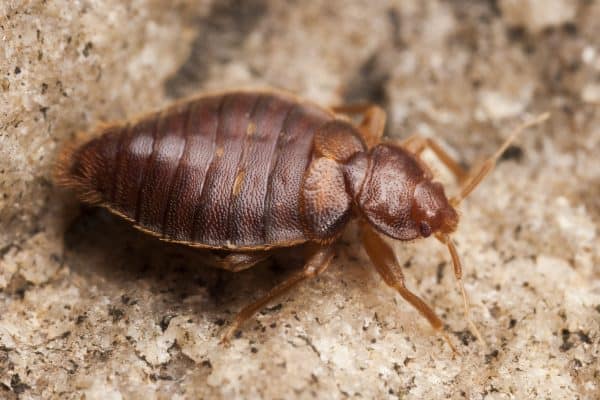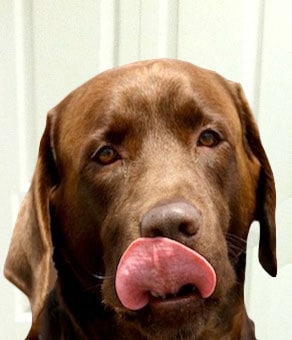Did You Know that Dogs Can Detect Bed Bugs?
The good news is that dogs can be trained to sniff out and locate bed bugs in most locations. If you have bed bugs in your home, a qualified exterminator may bring a trained dog to sniff out and locate the bed bugs in your home. But before we go into how these canines use their noses to find these pesky little bed bugs, let’s discuss what they are and why these critters can be such a nuisance.
What Are Bed Bugs?
 More than just a nuisance, bed bugs can completely infest homes, hotels and other locations, causing numerous problems. Bedbugs can be found all over the world. But what are these tiny critters? According to MedicineNet, “Bedbugs are small oval non-flying insects that belong to the insect family Cimicidae, which includes three species that bite people. Adult bedbugs can reach 5 mm-7 mm in length, while nymphs, or juveniles are as small as 1.5 mm. Bedbugs have flat bodies and may sometimes be mistaken for ticks or small cockroaches. Bedbugs feed by sucking blood from humans or animals. Adult bedbugs are reddish brown in color, appearing more reddish after feeding on a blood meal. Nymphs are clear in color and appear bright red after feeding. The wings of bedbugs are vestigial, so they cannot fly. However, they are able to crawl rapidly. They prefer temperatures between 70 and 80 degrees Fahrenheit and they can reproduce up to three times a year.”
More than just a nuisance, bed bugs can completely infest homes, hotels and other locations, causing numerous problems. Bedbugs can be found all over the world. But what are these tiny critters? According to MedicineNet, “Bedbugs are small oval non-flying insects that belong to the insect family Cimicidae, which includes three species that bite people. Adult bedbugs can reach 5 mm-7 mm in length, while nymphs, or juveniles are as small as 1.5 mm. Bedbugs have flat bodies and may sometimes be mistaken for ticks or small cockroaches. Bedbugs feed by sucking blood from humans or animals. Adult bedbugs are reddish brown in color, appearing more reddish after feeding on a blood meal. Nymphs are clear in color and appear bright red after feeding. The wings of bedbugs are vestigial, so they cannot fly. However, they are able to crawl rapidly. They prefer temperatures between 70 and 80 degrees Fahrenheit and they can reproduce up to three times a year.”
Where Do You Find Bed Bugs?
Bed bugs can infest homes, motels and even upscale hotels. Since bedbugs can arrive on the clothing or in the suitcases of guests from infested homes or other places that may be harboring the pests, hotels can be an easy target for bedbug infestations. In addition to hotels, bedbug infestations have been found in office buildings, laundry mats, homeless shelters, vehicles, and other locations where people may congregate.
Bedbugs can live in any area of a house, apartment or living space and they often hide in tiny cracks in furniture as well as inside upholstered furniture. They are common in areas where people sleep and generally concentrate in beds, including mattresses or mattress covers, box springs, and bed frames. Other sites where bedbugs can often be found include curtains, carpets, inside dressers and other furniture, inside cracks in wallpaper and in closets.
How Can Bed Bugs Spread From One Location to Another?
These bugs can spread by crawling and may contaminate multiple rooms in a home or even multiple dwellings in apartment buildings. They may also hide in boxes, suitcases, or other goods that are moved from place to place or from a hotel to a home or vice versa. Bedbugs can live on clothing from home infestations and may be spread by a person unknowingly wearing infested clothing.
How Can You Successfully Get Rid of Bed Bugs?
The good news is that there are effective ways to get rid of the bed bugs in your homes. But before you get rid of them – you must find them. One of the most effective ways to detect bed bugs is with dogs. There are trained canine units that can successfully detect bed bugs in most locations.
 Bed Bug Detection Dogs
Bed Bug Detection Dogs
Over the years, many species of dogs have been used for their strong sense of smell to detect numerous substances from drugs to bombs to mold. Many types of dogs contain millions of receptors in their noses. These receptors help them to track scents inside and outside while helping them to distinguish between the slightest differences in scents.
How Effective are Bed Bug Sniffing Dogs?
With their superior sense of smell, dogs can indeed be trained to sniff out bedbugs. While it can take several hours for an exterminator to search through an entire room, tearing apart beds and furniture and pulling up floor boards to locate any bed bugs, dogs can smell the presence of live bed bug infestations, usually within minutes.
What types of dogs are used to detect bed bugs?
Dogs are commonly chosen based on their breed and level of energy. The best candidates should be energetic and contain biological traits that improve their sense of smell. Hunting breeds, such as Blood Hounds and Beagles, are popular breeds of dogs to use because they have been bred for centuries to seek out prey and retrieve animals for their handlers. Other breeds used include Border Collies, Jack Russell Terriers, Labradors, and Aussies. Smaller breeds are usually preferred because they are less intimidating to residents who have aversions to dogs. In some cases, smaller dogs can get into smaller and tighter locations.
How are dogs trained to detect bed bugs?
Training for bed bug detection usually begins with basic obedience lessons where the dog and handler learn to work with each other. The dog must learn several different commands and the best dogs should have a high desire to please their handlers. These dogs will also receive praise from the handler through vocal praise and treats.
The dog must be trained to be focused, so it does not get distracted while on the job. There is just as much training involved for the dog as there is for the handler. Both must be a good match so that complex bed bug detection training can be completed.
 How old are the dogs that become bed bug detectors?
How old are the dogs that become bed bug detectors?
The average age is between eight and twelve months, but some may start training when they are a little older (especially if they have been rescued from a shelter). The dogs need about eight hundred to one thousand hours of training before they are eligible for certification. Most training is performed at a specialized facility that is set up with realistic staging to detect bed bugs.
How do these dogs find the bed bugs?
The canine units that are the most effective in detecting bed bugs are well trained dogs that have an incredibly strong sense of smell. Scent detection adds a whole new dimension to a bed bug inspection. Bugs that might escape visual detection by a human may be detected by a bed bug sniffing dog. Bed bugs can be very difficult to detect, so using different methods may prove to be useful from one location to the next. The more bed bug detection tools that are used, the more likely you are to detect infestations early when bed bugs are the easiest to control.
Canine scent detection works especially well for large scale inspections where visual inspections are simply not practical, such as periodic inspections of hotel rooms, college dormitories, apartment complexes, movie theaters, schools, or bed bug infestations in office buildings.
The National Entomology Scent Detection Canine Association (NESDCA)
The NESDCA is an organization that was developed by pest control professionals to ensure the highest standards for Entomology Scent Detection Canines are upheld. The organization was developed to ensure proper training and treatment of bed bug sniffing dogs. They also created objectives for the association that include:
- Assisting scent detection dogs and canine units in training and continued improvement of all scent detecting work dogs
- Establishing a working standard for all scent detecting canines, handlers and trainers through an accreditation program
- Providing educational material through publications, visual aids and training seminars
- Developing standards for all bug detection dogs
How can a bed bug sniffing dog help in your home?
If you suspect bed bugs in your home, a well-trained canine with a strong sense of smell can be a highly effective tool for bed bug detection. Along with a qualified exterminator, these dogs will come into your home and sniff through all of the rooms that you request. A well-trained bed bug detection dog can usually identify very small numbers of live bed b

ugs, sometimes as few as one. Additionally, the dogs should be able to discriminate live bugs and viable eggs from evidence left over from an old infestation (fecal spotting, caste skins, empty egg shells, carcasses). Unless they are able to do this, it can be more difficult to distinguish between active and old infestations.
The benefit of using bed bug detection dogs is that these dogs can get to many places that a human inspector may not be able to. For example: an outlet with bed bugs behind it, a baseboard that has a few bugs behind it, eggs hidden along a carpet tack strip, under carpets, under dressers, in tiny closets. A scent-detection dog can go under a bed without an inspector having to take the mattress and box spring off. The dogs can detect bed bugs or their eggs in a pile of clothing or a toy box full of stuffed animals.
Beach Pest uses Highly Trained Bed Bug Detection Dogs to Handle Your Bed Bug Problem
Beach Pest has a team of trained dogs that can sniff out and locate any bed bugs that may be hiding in your home or any location. Once these dogs detect
the bed bugs, the experts at Beach Pest will show you proof of the infestation. A complex treatment plan can then be developed to rid your home of these pests. Call the professionals at Beach Pest at (929) 236-4400, to successfully treat a bed bug infestation in your home.


